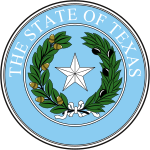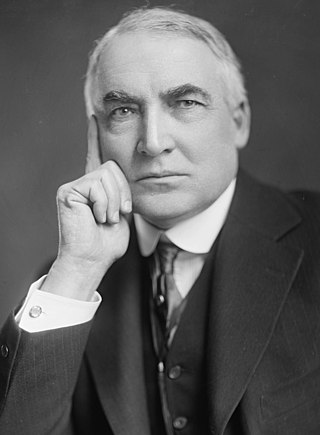
The 1920 United States presidential election was the 34th quadrennial presidential election, held on Tuesday, November 2, 1920. In the first election held after the end of the First World War and the first election after the ratification of the Nineteenth Amendment, Republican Senator Warren G. Harding of Ohio defeated Democratic Governor James M. Cox of Ohio. It was one of only six presidential elections where both major candidates had the same home state.

Samuel Houston was an American general and statesman who played an important role in the Texas Revolution. He served as the first and third president of the Republic of Texas and was one of the first two individuals to represent Texas in the United States Senate. He also served as the sixth governor of Tennessee and the seventh governor of Texas, the only individual to be elected governor of two different states in the United States.

The governor of Texas heads the state government of Texas. The governor is the leader of the executive and legislative branch of the state government and is the commander in chief of the Texas Military. The current governor is Greg Abbott, who took office in 2015.

Election Day in the United States is the annual day for general elections of federal public officials. It is statutorily set by the U.S. government as "the Tuesday next after the first Monday in November", i.e. the Tuesday that occurs within November 2 to November 8.

For about a hundred years, from after Reconstruction until the 1990s, the Democratic Party dominated Texas politics, making part of the Solid South. In a reversal of alignments, since the late 1960s, the Republican Party has grown more prominent. By the 1990s, it became the state's dominant political party and remains so to this day, as Democrats have not won a statewide race since the 1994 Lieutenant gubernatorial election.

The Constitution of the State of Texas is the document that establishes the structure and function of the government of the U.S. state of Texas, and enumerates the basic rights of the citizens of Texas.
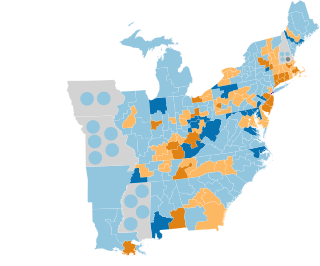
The 1844–45 United States House of Representatives elections were held on various dates in various states between July 1, 1844, and November 4, 1845. Each state set its own date for its elections to the House of Representatives. 224 elected members representing 27 states took their seats when the first session of the 29th United States Congress convened on December 1, 1845. The new state of Florida elected its first representative during this election cycle, while one vacancy in New Hampshire's delegation remained unfilled for the duration of the 29th Congress.
The 1860 Constitutional Union National Convention met on May 9, 1860, in Baltimore, Maryland. It was the only national convention ever held by the Constitutional Union Party, which was organized largely by former Whig Party members from the Southern United States who opposed secession. The convention nominated former Senator John Bell of Tennessee for president and former Secretary of State Edward Everett of Massachusetts for vice president.
The 1928 Democratic National Convention was held at Sam Houston Hall in Houston, Texas, June 26–28, 1928. The keynote speaker was Claude G. Bowers. The convention resulted in the nomination of Governor Alfred E. Smith of New York for president and Senator Joseph T. Robinson of Arkansas for vice president.

The Texas attorney general is the chief legal officer of the U.S. state of Texas. The current officeholder, Republican Ken Paxton, has been elected to the position since January 5, 2015 by the general election
The Texas Democratic Party is the affiliate of the Democratic Party in the U.S. state of Texas and one of the two major political parties in the state. The party's headquarters are in Austin, Texas.

George W. Bush served as the 46th governor of Texas from 1995 until 2000, when he resigned as governor amid his transition into the U.S. presidency after having been elected president in the 2000 United States presidential election. As governor, Bush successfully sponsored legislation for tort reform, increased education funding, set higher standards for schools, and reformed the criminal justice system. Bush also pioneered faith-based welfare programs and helped make Texas the leading producer of wind powered electricity in the US.

The legal status of Texas is the standing of Texas as a political entity. While Texas has been part of various political entities throughout its history, including 10 years during 1836–1846 as the independent Republic of Texas, the current legal status is as a state of the United States of America.

From 1836 to 1845, the Republic of Texas elected its own presidents. In 1845, it was admitted to the United States as the state of Texas, and has been a participant in every presidential election since, except for 1864 and 1868. Texas did not participate in these due to its secession from the United States to join the Confederate States of America on February 1, 1861, and its status as an unreconstructed state in 1868 following the American Civil War.
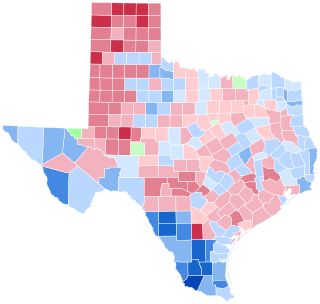
The 1992 United States presidential election in Texas took place on November 3, 1992, as part of the 1992 United States presidential election. Voters chose 32 representatives, or electors to the Electoral College, who voted for president and vice president.

The 1836 Republic of Texas presidential election was the first such election in the newly established Republic of Texas. Popular war hero Samuel Houston was elected in a decisive victory over Henry Smith and Stephen F. Austin. Houston was inaugurated on October 22, 1836, replacing interim president David G. Burnet.
The 1844 Republic of Texas presidential election was the fourth and last presidential election. It was held on September 2, 1844. The contest was held between Anson Jones and Edward Burleson, the vice president of the Republic of Texas. Jones defeated Burleson by a margin of 1,376 votes to become the fourth and final President of Texas.

The 1848 United States presidential election in Texas was held on November 7, 1848, as part of the 1848 United States presidential election. State voters chose four electors to represent the state in the Electoral College, which chose the president and vice president.
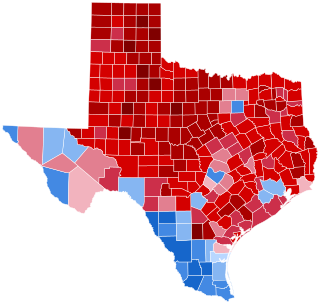
The 2016 United States presidential election in Texas took place on November 8, 2016, as part of the 2016 United States presidential election. Primary elections were held on March 1, 2016.

The 1952 United States presidential election in Texas was held on November 4, 1952. It was part of the 1952 United States presidential election held throughout all contemporary forty-eight states. Voters chose twenty-four representatives, or electors, to the Electoral College, who voted for president and vice president.


